Abstract
Neuropeptides are an important group of hormones mediating or modulating neuronal communication. Neuropeptides are especially abundant in evolutionarily "old" nervous systems, such as those of cnidarians, the lowest animal group having a nervous system. Cnidarians often have a life cycle including a polyp, a medusa, and a planula larva stage. Recently, a neuropeptide, < Glu-Gln-Pro-Gly-Leu-Trp-NH2, has been isolated from sea anemones that induces metamorphosis in a hydroid planula larva to become a hydropolyp [Leitz, T., Morand, K. & Mann, M. (1994) Dev. Biol. 163, 440-446]. Here, we have cloned the precursor protein for this metamorphosis-inducing neuropeptide from sea anemones. The precursor protein is 514-amino acid residues long and contains 10 copies of the immature, authentic neuropeptide (Gln-Gln-Pro-Gly-Leu-Trp-Gly). All neuropeptide copies are preceded by Xaa-Pro or Xaa-Ala sequences, suggesting a role for dipeptidyl aminopeptidase in neuropeptide precursor processing. In addition to these neuropeptide copies, there are 14 copies of another, closely related neuropeptide sequence (Gln-Asn-Pro-Gly-Leu-Trp-Gly). These copies are flanked by basic cleavage sites and, therefore, are likely to be released from the precursor protein. Furthermore, there are 13 other, related neuropeptide sequences having only small sequence variations (the most frequent sequence: Gln-Pro-Gly-Leu-Trp-Gly, eight copies). These variants are preceded by Lys-Arg, Xaa-Ala, or Xaa-Pro sequences, and are followed by basic cleavage sites, and therefore, are also likely to be produced from the precursor. Thus, there are at least 37 closely related neuropeptides localized on the precursor protein, making this precursor one of the most productive preprohormones known so far. This report also shows that unusual processing sites are common in cnidarian preprohormones.
Full text
PDF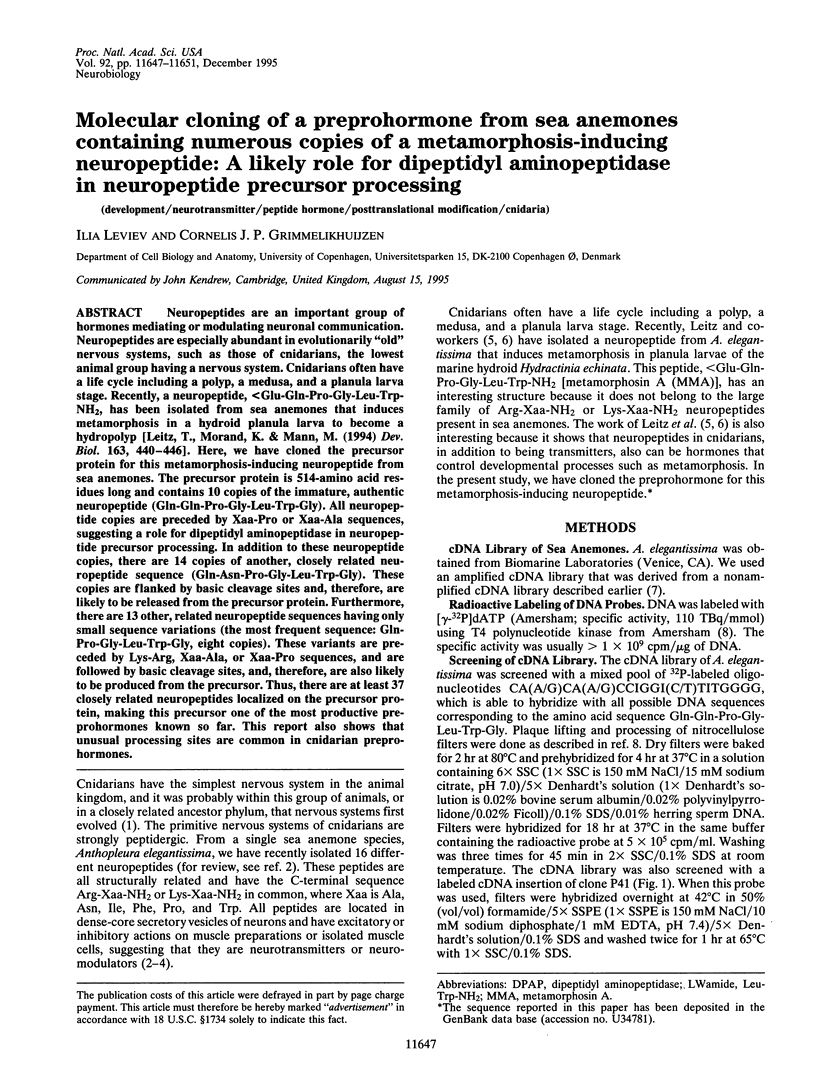
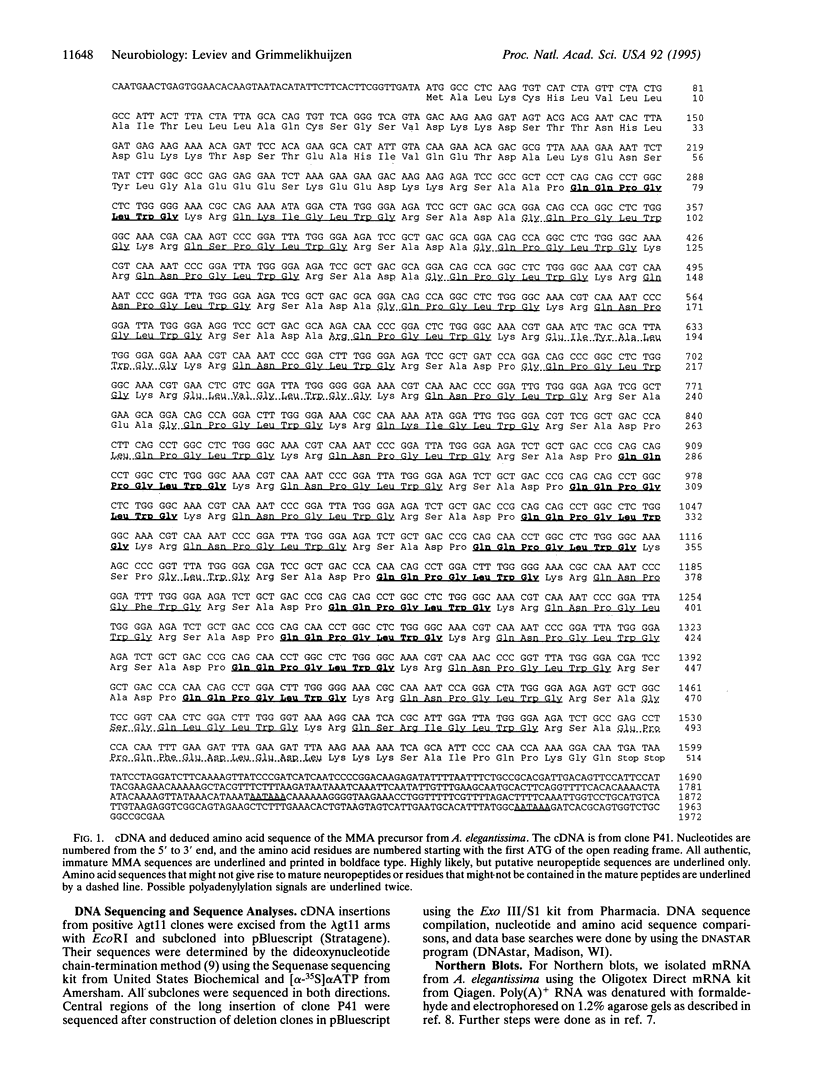
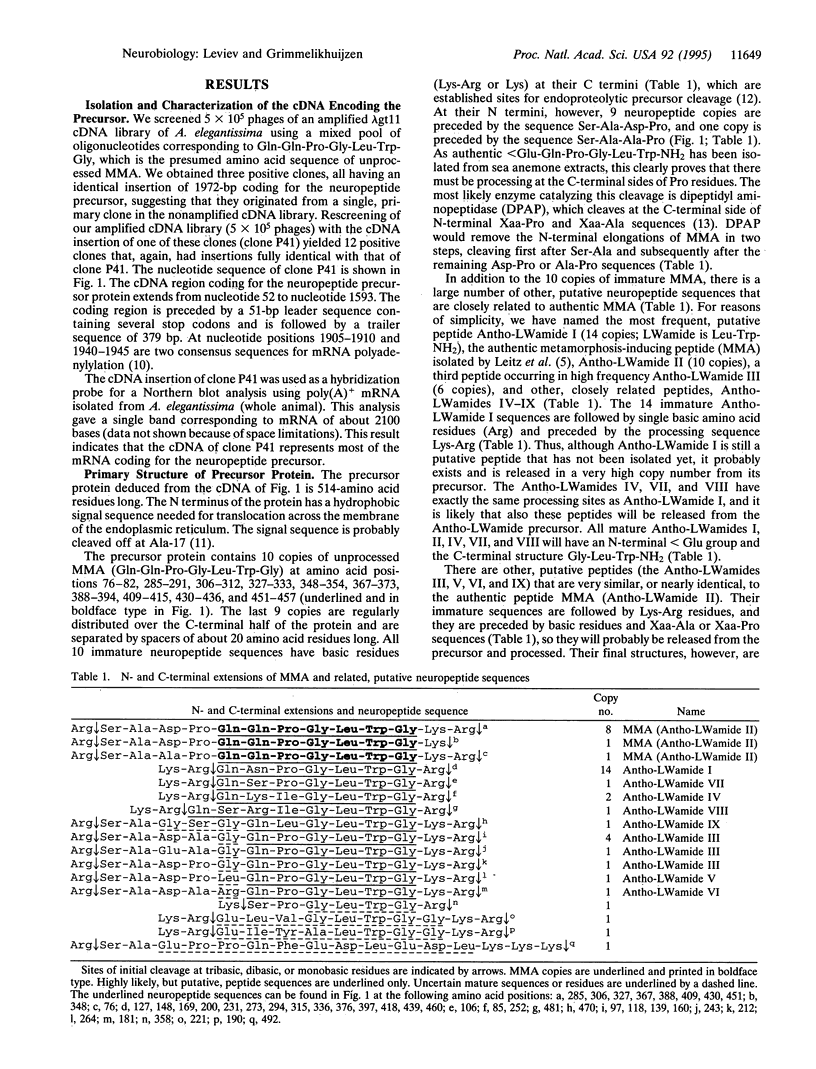
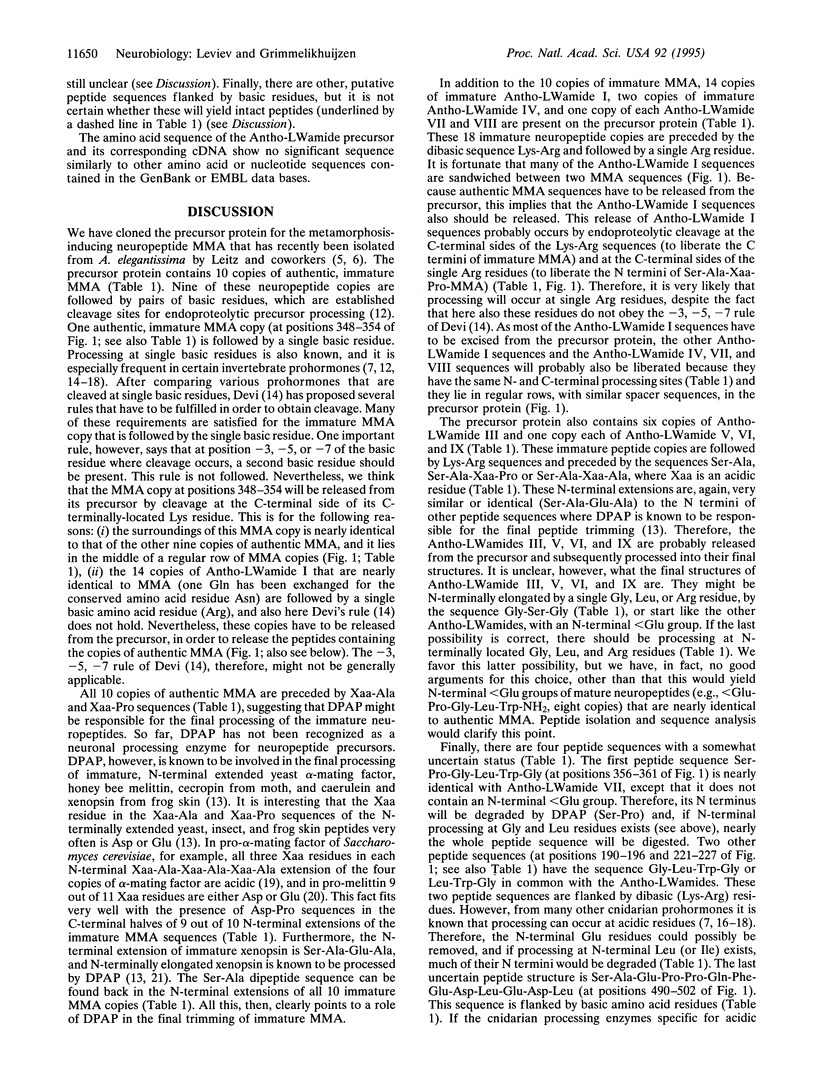
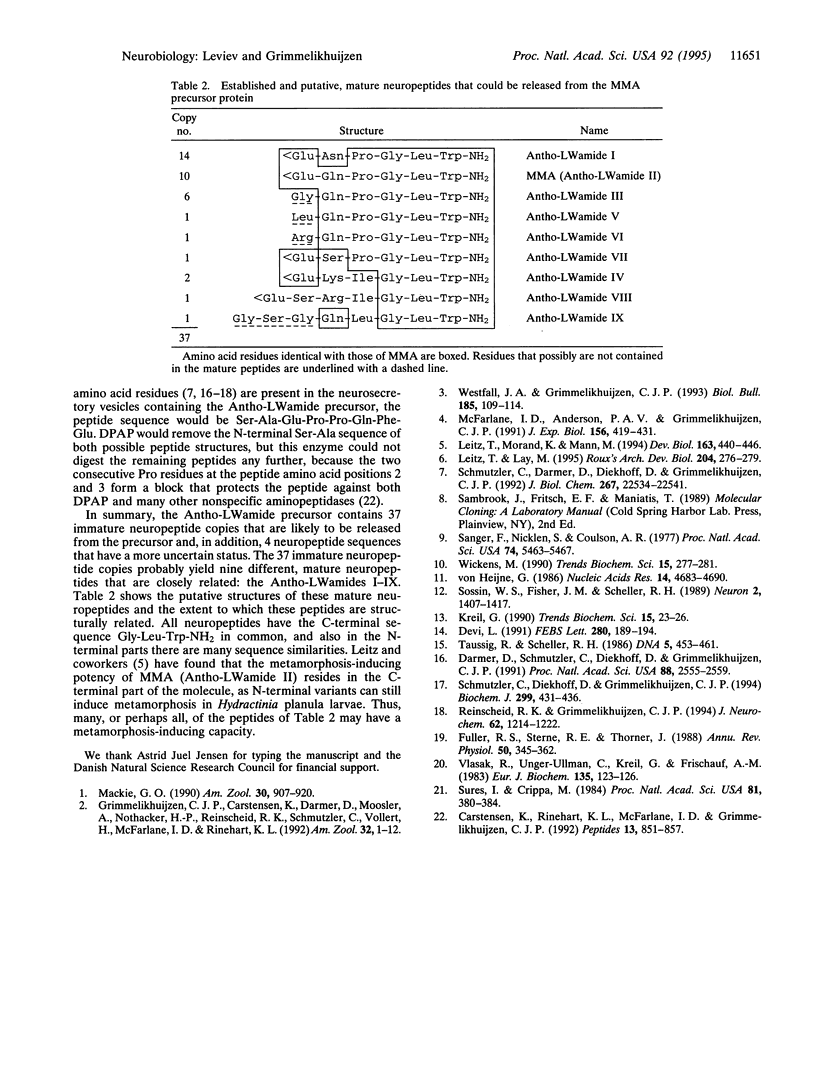
Selected References
These references are in PubMed. This may not be the complete list of references from this article.
- Carstensen K., Rinehart K. L., McFarlane I. D., Grimmelikhuijzen C. J. Isolation of Leu-Pro-Pro-Gly-Pro-Leu-Pro-Arg-Pro-NH2 (Antho-RPamide), an N-terminally protected, biologically active neuropeptide from sea anemones. Peptides. 1992 Sep-Oct;13(5):851–857. doi: 10.1016/0196-9781(92)90040-a. [DOI] [PubMed] [Google Scholar]
- Darmer D., Schmutzler C., Diekhoff D., Grimmelikhuijzen C. J. Primary structure of the precursor for the sea anemone neuropeptide Antho-RFamide (less than Glu-Gly-Arg-Phe-NH2). Proc Natl Acad Sci U S A. 1991 Mar 15;88(6):2555–2559. doi: 10.1073/pnas.88.6.2555. [DOI] [PMC free article] [PubMed] [Google Scholar]
- Devi L. Consensus sequence for processing of peptide precursors at monobasic sites. FEBS Lett. 1991 Mar 25;280(2):189–194. doi: 10.1016/0014-5793(91)80290-j. [DOI] [PubMed] [Google Scholar]
- Fuller R. S., Sterne R. E., Thorner J. Enzymes required for yeast prohormone processing. Annu Rev Physiol. 1988;50:345–362. doi: 10.1146/annurev.ph.50.030188.002021. [DOI] [PubMed] [Google Scholar]
- Kreil G. Processing of precursors by dipeptidylaminopeptidases: a case of molecular ticketing. Trends Biochem Sci. 1990 Jan;15(1):23–26. doi: 10.1016/0968-0004(90)90126-v. [DOI] [PubMed] [Google Scholar]
- Leitz T., Morand K., Mann M. Metamorphosin A: a novel peptide controlling development of the lower metazoan Hydractinia echinata (Coelenterata, Hydrozoa). Dev Biol. 1994 Jun;163(2):440–446. doi: 10.1006/dbio.1994.1160. [DOI] [PubMed] [Google Scholar]
- McFarlane I. D., Anderson P. A., Grimmelikhuijzen C. J. Effects of three anthozoan neuropeptides, Antho-RWamide I, Antho-RWamide II and Antho-RFamide, on slow muscles from sea anemones. J Exp Biol. 1991 Mar;156:419–431. doi: 10.1242/jeb.156.1.419. [DOI] [PubMed] [Google Scholar]
- Reinscheid R. K., Grimmelikhuijzen C. J. Primary structure of the precursor for the anthozoan neuropeptide antho-RFamide from Renilla köllikeri: evidence for unusual processing enzymes. J Neurochem. 1994 Mar;62(3):1214–1222. doi: 10.1046/j.1471-4159.1994.62031214.x. [DOI] [PubMed] [Google Scholar]
- Sanger F., Nicklen S., Coulson A. R. DNA sequencing with chain-terminating inhibitors. Proc Natl Acad Sci U S A. 1977 Dec;74(12):5463–5467. doi: 10.1073/pnas.74.12.5463. [DOI] [PMC free article] [PubMed] [Google Scholar]
- Schmutzler C., Darmer D., Diekhoff D., Grimmelikhuijzen C. J. Identification of a novel type of processing sites in the precursor for the sea anemone neuropeptide Antho-RFamide (<Glu-Gly-Arg-Phe-NH2) from Anthopleura elegantissima. J Biol Chem. 1992 Nov 5;267(31):22534–22541. [PubMed] [Google Scholar]
- Schmutzler C., Diekhoff D., Grimmelikhuijzen C. J. The primary structure of the Pol-RFamide neuropeptide precursor protein from the hydromedusa Polyorchis penicillatus indicates a novel processing proteinase activity. Biochem J. 1994 Apr 15;299(Pt 2):431–436. doi: 10.1042/bj2990431. [DOI] [PMC free article] [PubMed] [Google Scholar]
- Sossin W. S., Fisher J. M., Scheller R. H. Cellular and molecular biology of neuropeptide processing and packaging. Neuron. 1989 May;2(5):1407–1417. doi: 10.1016/0896-6273(89)90186-4. [DOI] [PubMed] [Google Scholar]
- Sures I., Crippa M. Xenopsin: the neurotensin-like octapeptide from Xenopus skin at the carboxyl terminus of its precursor. Proc Natl Acad Sci U S A. 1984 Jan;81(2):380–384. doi: 10.1073/pnas.81.2.380. [DOI] [PMC free article] [PubMed] [Google Scholar]
- Taussig R., Scheller R. H. The Aplysia FMRFamide gene encodes sequences related to mammalian brain peptides. DNA. 1986 Dec;5(6):453–461. doi: 10.1089/dna.1.1986.5.453. [DOI] [PubMed] [Google Scholar]
- Vlasak R., Unger-Ullmann C., Kreil G., Frischauf A. M. Nucleotide sequence of cloned cDNA coding for honeybee prepromelittin. Eur J Biochem. 1983 Sep 1;135(1):123–126. doi: 10.1111/j.1432-1033.1983.tb07626.x. [DOI] [PubMed] [Google Scholar]
- Wickens M. How the messenger got its tail: addition of poly(A) in the nucleus. Trends Biochem Sci. 1990 Jul;15(7):277–281. doi: 10.1016/0968-0004(90)90054-f. [DOI] [PubMed] [Google Scholar]
- von Heijne G. A new method for predicting signal sequence cleavage sites. Nucleic Acids Res. 1986 Jun 11;14(11):4683–4690. doi: 10.1093/nar/14.11.4683. [DOI] [PMC free article] [PubMed] [Google Scholar]


